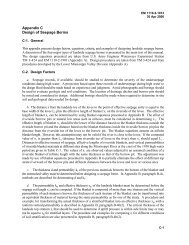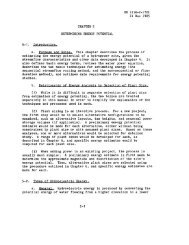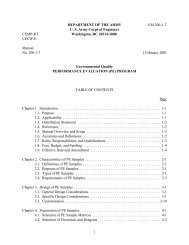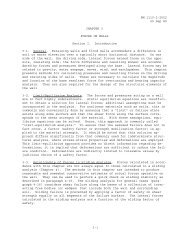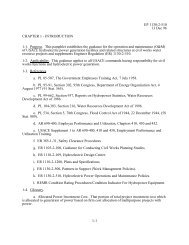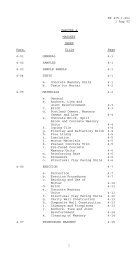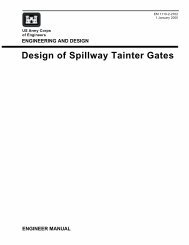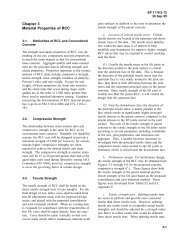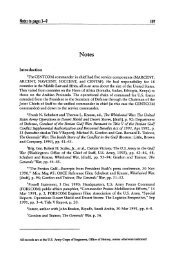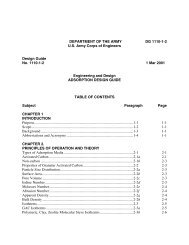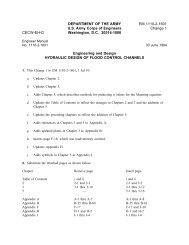Earthquake Design and Evaluation of Concrete Hydraulic Structures
Earthquake Design and Evaluation of Concrete Hydraulic Structures
Earthquake Design and Evaluation of Concrete Hydraulic Structures
Create successful ePaper yourself
Turn your PDF publications into a flip-book with our unique Google optimized e-Paper software.
Chapter 5<br />
<strong>Concrete</strong> Properties <strong>and</strong> Capacities<br />
5-1. Plain <strong>Concrete</strong> <strong>Structures</strong><br />
EM 1110-2-6053<br />
1 May 2007<br />
a. General. The concrete properties important in the seismic design <strong>and</strong> evaluation <strong>of</strong><br />
concrete dams are the unit weight, compressive, tensile, <strong>and</strong> shear strengths, modulus <strong>of</strong><br />
elasticity, <strong>and</strong> Poisson’s ratio. Properties <strong>of</strong> mass concrete at high rate <strong>of</strong> loading are higher<br />
than those under static loading conditions. Therefore, concrete properties used in the seismic<br />
analysis should reflect the effects <strong>of</strong> high deformation rates <strong>and</strong> cyclic loading response that the<br />
dam would experience under earthquake shaking. In general, the performance <strong>of</strong> a dam under<br />
earthquake loading is controlled by the tensile strength <strong>of</strong> the concrete, <strong>and</strong> by tensile crack<br />
propagation. However, the actual tensile strength used in performance evaluation <strong>of</strong> the dam<br />
should be determined by taking into account the effects <strong>of</strong> lift joints. The actual tensile strength<br />
across the poorly constructed lift joints <strong>of</strong> some older dams could be markedly lower than that<br />
for the homogeneous concrete. Thus it is important that such weaknesses in the mass concrete<br />
are accounted for in the seismic safety evaluation, <strong>and</strong> that the actual reduced strength at lift<br />
joints is determined by material testing. The properties <strong>of</strong> concrete for the final design <strong>and</strong><br />
evaluation should also be determined by testing.<br />
b. Testing. A comprehensive laboratory testing program is required to obtain the design<br />
mixture proportions for concrete strength <strong>and</strong> workability, to obtain the material properties<br />
important to structural analysis <strong>and</strong> thermal studies, <strong>and</strong> to validate in-place concrete strengths<br />
<strong>of</strong> both the parent concrete <strong>and</strong> lift joints. A measure <strong>of</strong> tensile strength <strong>of</strong> the concrete can be<br />
obtained from direct tension, modulus <strong>of</strong> rupture, or splitting tension tests. The direct tension<br />
tests <strong>of</strong> concrete are seldom carried out due to difficulties associated with the specimen holding<br />
devices. The modulus <strong>of</strong> rupture test is not favored for existing structures because <strong>of</strong> its beam<br />
specimen requirement. The most commonly used test for estimating the tensile strength <strong>of</strong> the<br />
concrete is the ASTM 496 splitting tension test, which uses a cylindrical specimen.<br />
Relationships between the tensile strength obtained from splitting tensile tests <strong>and</strong> direct tensile<br />
strength, for both conventional concrete <strong>and</strong> RCC, are given in EM 1110-2-2200.<br />
c. <strong>Concrete</strong> Coring <strong>and</strong> Specimen Parameters. A concrete coring program to obtain test<br />
specimens should start with a r<strong>and</strong>om coring or non-destructive tests to establish the overall<br />
quality <strong>and</strong> uniformity <strong>of</strong> concrete, <strong>and</strong> to locate problem areas in existing structures. Once<br />
potential areas have been discovered, coring can concentrate in these areas to better define<br />
properties. While average values <strong>of</strong> strength <strong>and</strong> elastic modulus <strong>of</strong> the concrete are <strong>of</strong> some<br />
value for structural analysis, coring <strong>and</strong> testing should focus on “weak links” since these<br />
problem areas are more likely to govern performance <strong>of</strong> the structure, than the average<br />
properties. Another important factor in establishing the concrete properties is that sufficient<br />
number <strong>of</strong> specimens are taken <strong>and</strong> tested so that the uncertainty in the estimated parameter<br />
values are reduced to an acceptable level. The number <strong>of</strong> tests needed to establish the<br />
concrete properties depends on statistical considerations <strong>and</strong> cost. While for few tests (say less<br />
than 5), adding an additional test results in significant reduction in the uncertainty, for many<br />
tests, the reduction obtained by using an additional test is small. So the engineer must answer<br />
the question: “Is the additional precision obtained by using another test worth the additional<br />
expense?” As a general guideline the minimum number <strong>of</strong> tests for a specific parameter is about<br />
six, while more than nine tests would probably not be economical.<br />
5-1




